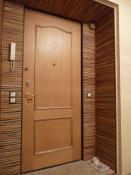Search
Login
What is the advantage of heating a house with underfloor heating
By removing wall heaters (radiators) and heating the premises using a device for heated water floors, design possibilities for interior design are expanding. But great design means a great atmosphere and decent savings in operating costs.
Content
- General information
- Electric underfloor heating
- Water floor heating video
- System of underfloor heating using pipes made of cross-linked polyethylene
- System of water heat-insulated floors using metal-plastic pipes
- The use of water heating to combat icing on the street
- Installation technology for heating circuits video
- Water heating - replacing the air conditioner in the summer
- What is included in the water floor heating system
General information
Heating a room using underfloor heating involves placing heating circuits in the floor structure, while the installation system is not visible to the consumer’s eye, i.e. decorative camouflage is excluded.
If you don’t know anything about warm floors, then the question arises - why is it so warm in this house?
At the same time, heat is distributed evenly throughout the entire volume of the room.
A warm floor fully provides the saying: Keep your head in the cold and your feet warm.
In the area of \u200b\u200bthe legs, a temperature of 24-26 * C is maintained, and in the area of \u200b\u200bthe head - a temperature of 20 * C, near the ceiling - 17-19 * C.
It is clear that under such conditions, you feel comfortable without slippers, there are no drafts, and since they are absent, you will not see flying dust.
Warm floors are electric and water.
Electric underfloor heating
An electric heated floor is created using a resistive electric cable.
Electric underfloor heating is perfect for heating bathrooms, toilets, for the kitchen and hallway.
Electric underfloor heating is an excellent type of heating for urban apartments, since the installation of water floors for urban apartments is significantly limited by law.
But, for heating large areas, you must understand that a large consumption of electricity is required.
Therefore, in urban apartments, they usually install an electric underfloor heating not completely over the entire area, but complete with basic heating using water-wall radiators.
Water floor heating
Water floor heating does not require large expenditures of electricity, therefore, for heating a private and country house - this is the best way of heating.
The heating element of the water floor heating is an extensive network of underground pipelines.
In pipelines, water or other coolant moves in a closed loop.
All heating circuits are connected to the collector.
The collector is an intermediate link between water loops and a heat generator.
At the same time, water floor heating is a low-temperature heating system. At the entrance to the supply pipe, the coolant temperature is not higher than 50 * C, in the return pipe 40 * C.
Thus, there is an economical use of energy, i.e. the boiler operates in an economical mode, with proper adjustment, the microclimate in the house changes smoothly.
To heat the room, it is possible to use natural sources of heat (sun, wind, use the heat of the earth and water).
During construction, a heat engineering calculation is made for building heating.
All design features of the building, losses on window and door openings are laid in the calculation, local climatic conditions are taken into account.
If floor heating is not enough, it is combined with heating using low-temperature radiators, collectors, air curtains are installed.
System of underfloor heating using pipes made of cross-linked polyethylene
When installing water heat-insulated floors, cross-linked polyethylene pipes are widely used.
The latest technologies allow manufacturers to create a polymer in which linear molecular chains produce compounds and form a stable spatial structure.
The material has high flexibility and elasticity.
Crosslinked polyethylene is produced in various ways, but any crosslinked polyethylene is not subjected to corrosion, has high resistance to chemical aggressive environments.
The pipe made of cross-linked polyethylene does not have hydroabrasive wear, since it is absolutely smooth.
The smoothness of the pipe does not allow carbonate and other deposits to be deposited on the pipe walls, i.e. overgrowing of the pipeline does not occur.
Pipes made of cross-linked polyethylene do not conduct stray currents, they delay shock noises and at the same time, installation is very fast and simple.
System of water heat-insulated floors using metal-plastic pipes
Metal-plastic pipes are metal-polymer, aluminum foil, which is part of such pipes, is an oxygen barrier.
Plastic pipes have a three-layer structure.
Inside is cross-linked polyethylene, on top is a metal layer, on the outside is cross-linked polyethylene of high stability.
Using special glue, there is a reliable adhesion of different materials. The metal does not allow oxygen to penetrate, creates increased strength indicators, reduces linear temperature motion, and provides resistance to hydraulic shocks.
Important! Metal pipes are subject to electromagnetic fields, and this can lead to an accident.
It is possible to purchase metal-plastic pipes only from reliable suppliers and reliable manufacturers' firms - thereby you protect yourself from big problems.
The use of water heating to combat icing on the street
Our climatic conditions, in the winter, lead to icing of access roads, steps, to the formation of icicles - and all this threatens human life and health.
To combat icing, a water heating system is widely used.
In places of active movement of people, under the pavement, heating pipelines are laid.
Such heating saves the owner from the need for constant snow removal and ice chipping.
To prevent the formation of ice and icicles, along the perimeter of pitched and flat roofs, water heating circuits are mounted.
Although cable heating has gained wider application, but in terms of economy, water heating bypasses cable heating a lot.
Installation technology for heating circuits
In the production of heating circuits, various installation technology is used.
High energy-saving performance is laying the pipeline in a concrete screed.
Since concrete has high thermal energy, when the heating is turned off, the heat collected by concrete is transferred to the room for a rather long time.
To increase the efficiency of the system, thermal insulation of the substrate is created, it delays thermal energy, thereby increasing the efficiency of heating.
If the house has wooden floors, flooring is used during installation.
Pipes are mounted in profiled plates, these plates are attached to special plates.
To increase the efficiency of water floors, foil material is often used.
The foil reflects thermal energy into the room and provides an even distribution of heat.
Water heating - replacing the air conditioner in the summer
In the warmer months, a water heating system can cool the air.
This requires much less energy than with air conditioners.
Separate systems of advanced companies provide excellent comfort and save up to 40% energy.
Using a water floor instead of an air conditioner completely eliminates the formation of drafts, maintains a wonderful atmosphere in the house, does not spoil the facade of the building, thereby the owners get a kind of bonus in the form of coolness in the summer heat.
What is included in the water floor heating system
For the effective operation of water floor heating, measuring and control devices are installed.
The water floor heating system is equipped with circulation pumps, flow controllers are installed.
Everything is controlled by electronics using thermostatic valves and remote thermostats.
Air and integrated sensors constantly monitor the ambient temperature.
With any change in the microclimate, the liquid is heated in the heating circuit or the liquid is cooled due to a mixture of cold water.





